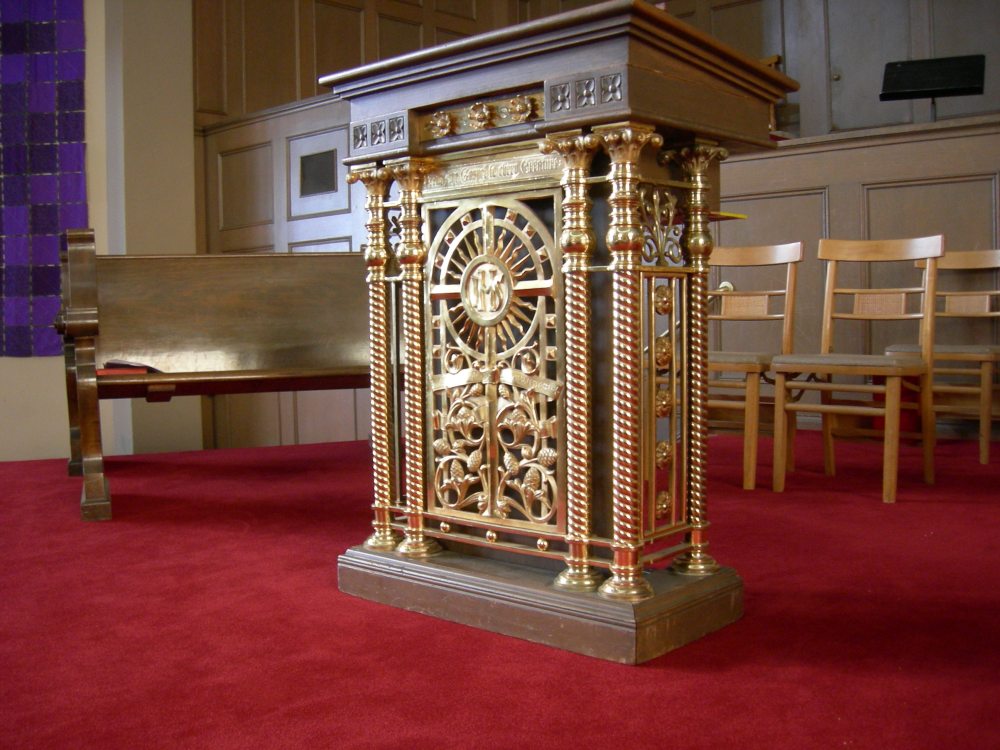Old First United Methodist Church, Seattle, Washington
Image Source = Joe Mabel
Confirmation of This Identification Available from The Seattle Times
++++++++++++++++++++++++++++++++++++++++++++++++++++++++++
Methodism began as a revival movement in The Church of England. Along the way it abandoned The Book of Common Prayer, even though U.S. Methodist Communion rituals prior to the 1989 United Methodist Hymnal were based on the English Prayer Book tradition. My point is this: I, raised a United Methodist, converted to The Episcopal Church in 1991 and embraced the Prayer Book. Yes, as a friend of an acquaintance stated the case a few months ago, I left the church John Wesley made for the church that made John Wesley. Now, when I say “Prayer Book” to most United Methodists I encounter, I receive mostly confused looks.
The Methodist Church (1939-1968), a predecessor of The United Methodist Church (1968-present), issued its first Book of Worship in 1945 and the second BOW twenty years later. Each volume was for public and private use, much like the Episcopal Book of Common Prayer. Yet Methodism’s character was already forged; it did not become a Prayer Book tradition. So the Book of Worship lived in church offices, not pews. The United Methodist Book of Worship (1992) is likewise a mystery to many, if not most, United Methodists.
Among my many prized thrift-store book section finds is the Companion of The Book of Worship, Edited for the Commission on Worship for The United Methodist Church by William F. Dunkle, Jr., and Joseph D. Quillian, Jr. (Nashville, TN: Abingdon Press, 1970). M. Lawrence Snow, then pastor at Community United Methodist Church, Poughkeepsie, New York, contributed the chapter about using the BOW with home and small groups. Yes, Rev. Snow was a ritualist. During Internet searches I discovered his fondness for Ash Wednesday ashes here (http://www.nytimes.com/1993/02/24/nyregion/for-more-protestants-new-rite-for-lent-growing-number-congregations-accept-use.html) and his 2009 obituary here (http://www.nyac.com/obituaries/detail/12). In four paragraphs on page 181 of the Companion Snow analyzed what he considered “Problems of Methodist Worship.” He wrote:
Methodists especially should not ignore the public implications of their private devotions. (As already indicated, “public” means both the services of the church and the affairs of the world.)
On one hand, the end of the class meeting and the decline of the prayer meeting in Methodism have further loosed the ties of intimate discipline and personal devotion from the public services (work and worship) of the church. On the other hand, pivotal events, such as the “wet-dry controversy destroyed in the minds of many supporters of Prohibition any sense of the proportionate importance of social [i.e., public, worldly] issues” other than pietistic ones like abstinence.
One of the consequences in recent times has been a dilution of Methodist notions of worship and particularly “devotions.” Our devotional literature is deprived; our devotional practices are in a state of disrepair. They are individualistic, subjective, and faintly effeminate. They tend to be overly moralistic, “psychological”; sometimes an acrostic of mystical classics. They seem artificial because they are not public; they are unchurchly and unworldly. They are private to the point of unreality.
Interestingly, the sermon, which Protestants have come to regard as the most important part of public worship, often mirrors the congregation’s deprived spirituality. Widely popular preaching deals with how persons can “get along” and “be good.” These themes narrow the responsibilities of worship and the humanity of the worshiper. They make God and his world too small.
I am not certain how Methodist worship in 1969-1970 was “faintly effeminate,” according to Snow, nor do I find “faintly effeminate” worship bothersome or offensive. As for the rest, I conclude that Snow did not find the rise of contemporary worship and “seven-eleven” praise choruses (ones with seven words one sings eleven times) comforting. I consider them even worse than annoying; they are theological tide pools.
Snow did grasp correctly the shortcomings of pietism and Jesus-and-meism. The world, you see, is not the enemy camp, the damned domain of Satan for which you and I have no responsibility. No, the world is our neighborhood. We and our forebears, by our actions and inactions, have made it what it is, for better and for worse. We are supposed to be lights to the nations, as well as our neighbors and coworkers and friends and acquaintances, et cetera. Do we put our lamps under a bushels, or do we let them shine? Do we focus so much on pietistic obsessions, such as alcohol and sex, that we excuse, actively or passively, economic and racial injustice? When we say that we love God fully and our neighbors as ourselves, do we try to act accordingly? Or do we content ourselves with mere words?
I have begun a multi-year practice of writing devotional blog posts, according to lectionaries. Many of these posts flow from the conviction that we will transform the world, or at least our corner of it, by our actions or inactions, and that we ought to do this for the good. These devotions exist at three blogs, which, together, cover the church year: ADVENT, CHRISTMAS AND EPIPHANY DEVOTIONS, LENTEN AND EASTER DEVOTIONS, and ORDINARY TIME DEVOTIONS. Pondering texts and writing devotions is a great spiritual exercise for me as I try, with more success on some days than on others, not, in the words of Rev. Snow, to “make God and his world too small.”
As for the current state of United Methodist devotional life, I defer to the judgment of those better informed than I am.
KENNETH RANDOLPH TAYLOR
JUNE 9, 2011 COMMON ERA
THE FEAST OF SAINT COLUMBA OF IONA, ROMAN CATHOLIC MISSIONARY AND ABBOT
+++++++++++++++++++++++++++++++++++++++++++++++++++++++++++++++++
Published originally at SUNDRY THOUGHTS OF KENNETH RANDOLPH TAYLOR


Leave a comment